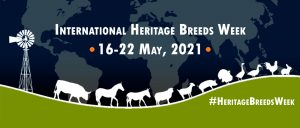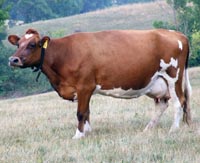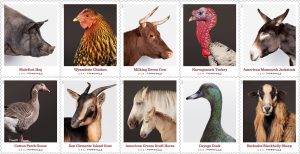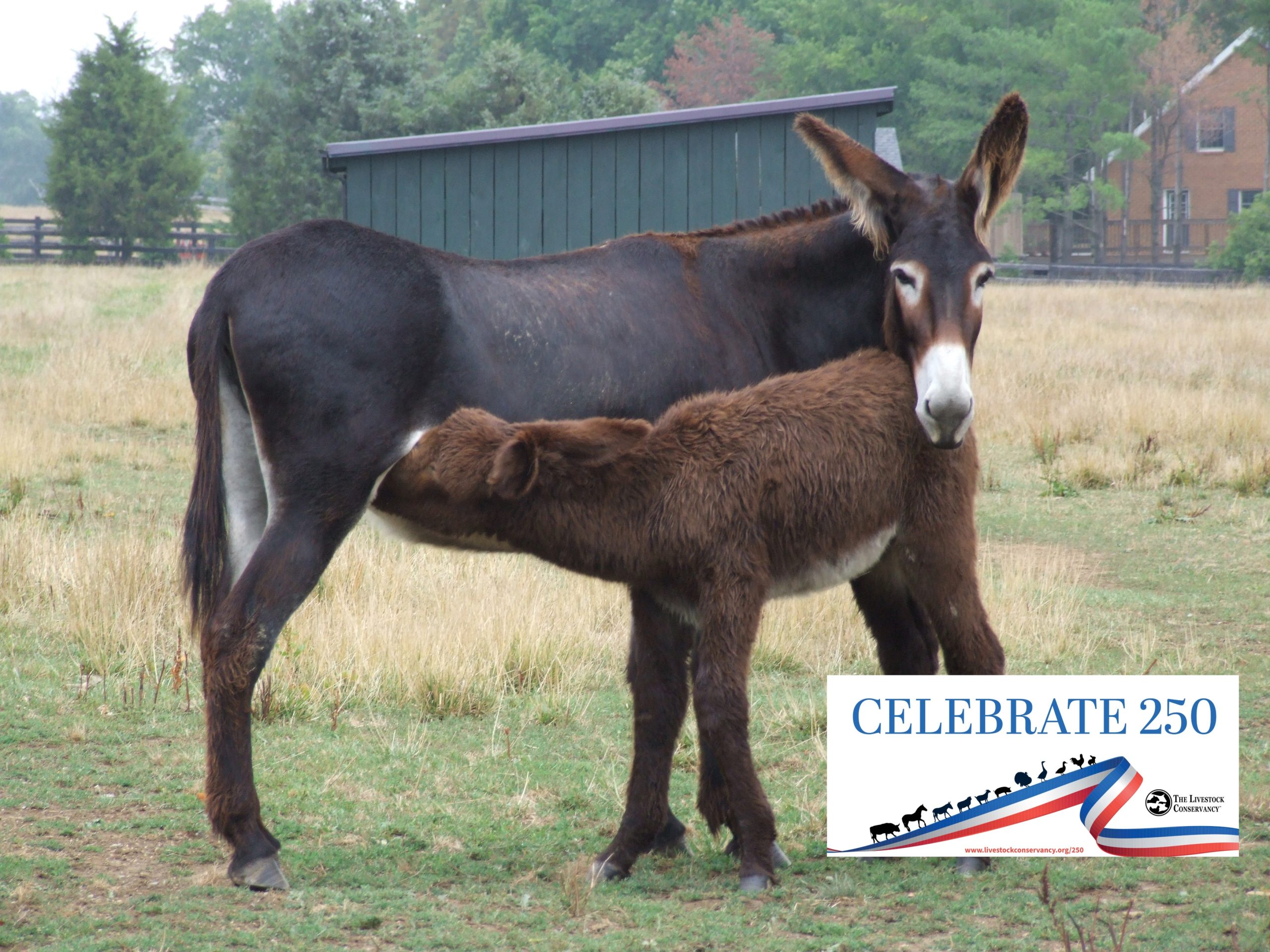FOR IMMEDIATE RELEASE
Contact: Brittany Sweeney
bsweeney@LivestockConservancy.org
(919) 542-5704
Pittsboro, NC, USA [May 14, 2021] – The Livestock Conservancy invites you to celebrate International Heritage Breeds Week, Sunday, May 16 through Saturday, May 22. During the third full week of May each year, conservation organizations, associations, farmers, ranchers, shepherds, and consumers share stories about how heritage breeds have impacted their lives, environments, and local economies. This global conversation raises awareness about endangered livestock and poultry breeds listed on our Conservation Priority List and about rare breeds around the world.
“We need more people raising heritage breeds, but we also need a larger market for their products,” said Alison Martin, executive director of The Livestock Conservancy. “It may seem counterintuitive, but in many cases, that means eating them to save them. Purchasing heritage breed food and fiber products gives farmers an incentive to breed more animals, which will eventually help them graduate from our Conservation Priority List.”
The ranked list of rare breeds is based on the annual number of registrations in the United States and the breed’s estimated global population size. This year, we celebrate the graduation of Ayrshire cattle during International Heritage Breeds Week. Ayrshire are the eighth breed we’ve graduated in eight years.
An excellent choice for small dairies, family farms, and mixed-breed dairy herds, Ayrshire cattle were imported from Scotland to the northeastern United States at least 200 years ago. These cows generally calve with ease and can produce 12,000 – 17,000 lbs. of milk per year, with an average milk fat content of 3.9%. A history of life in rugged landscapes gives them the ability to efficiently convert forage to milk, making Ayrshires productive dairying animals for grass-based operations.
Today, more than 3,000 Ayrshire cows are registered each year in the United States, and 5,000-6,000 are born annually in the United Kingdom. Worldwide, the population of Ayrshire cattle well exceeds the 25,000 animals needed for graduation. Strong partnerships among breed associations, breeders and owners are necessary for breeds to survive and grow in numbers, in addition to graduating and thriving in today’s agricultural landscape. Dedicated Ayrshire breeders and partners like the U.S. Ayrshire Breeders Association and other global conservation organizations helped make graduation possible for this hardy and long-lived breed.
A Stamp of Approval
The hard work of those saving heritage breed livestock and poultry from extinction is being honored with a United States Postal Service Forever Stamp. This special stamp collection features 10 breeds that played important roles in American history. The majority of theses breeds are only found in North America, and are adopted to fill unique agricultural niches. Through the efforts of The Livestock Conservancy, these breeds continue to contribute to today’s family farms and offer important biodiversity for the farms of tomorrow.
“These stamps pay tribute to heritage breeds, pre-industrial farm animals that are enjoying renewed attention for their versatility, adaptability, and unique genetic traits. Heritage breeds of livestock take us back to our agricultural roots – and show the way to a more sustainable future.” according to the US Postal Service.
The First Day of Issue Ceremony will be celebrated at George Washington’s Mount Vernon in Virginia and will be livestreamed at 11 am EST on Monday, May 17, as part of the International Heritage Breeds Week festivities. Watch the ceremony on The Livestock Conservancy’s Facebook Page or George Washington’s Mount Vernon YouTube Channel.
Still at Risk of Extinction
The wide variety of traits present in heritage breeds were carefully crafted by generations of farmers. They were bred for a specific purpose and for specific jobs. By raising awareness about these endangered breeds, we can give them back their jobs, whether that’s fiber, meat, milk, work, sport or conservation grazing. Giving breeds a purpose, and careful management and promotion by breeders and breed associations, are the keys to successful conservation efforts for rare and endangered lbreeds and for the future of agriculture.
Despite the many benefits that heritage breeds offer for biosecurity and sustainability, these breeds are still at risk of extinction. According to the Intergovernmental Science-Policy Platform on Biodiversity and Ecosystem Services (IPBES) findings in 2016, more than 9 percent of domesticated breeds of mammals used for food and agriculture had become extinct and at least 1,000 more are threatened with extinction. The State of the World’s Biodiversity for Food and Agriculture report predicts that at least 26 percent of the world’s local breeds of livestock are currently at risk and only 7 percent of breeds worldwide are secure. The status of the remaining 67 percent of breeds is unknown because of a lack of data and established conservation programs.
Once a breed goes extinct, its genetics are lost to history. These genetics are the raw materials that farmers may need to combat outbreaks of disease, a changing climate, or genetic issues that arise from inbreeding. The Food and Agriculture Organization of the United Nations estimates that one domesticated livestock breed is lost every month.
In industrialized areas of the world, agriculture relies on a few highly uniform and productive breeds to maximize the output of agricultural products. Many once-popular breeds that retain the majority of genetic diversity within a species have become rare. In som communities, farmers may embrace the high production rates of modern breeds and abandon their locally adapted, but less productive animals. While in some cases farmers may see short-term increases in production, they risk losing traditional breeds that may be crucial for farming in their regions. These local or regional breeds may also be imortant in other geographic areas as needs of communities change. If highly-adapted and verstatile breeds are lost, we risk losing the very genetic resources we may need to help us adapt animal agriculture fto meet future needs.
“Just because a breed is the most productive, doesn’t mean that it should be the only breed raised,” Martin said. “We know that diversity in agriculture brings strength and adaptability in an ever-changing climate. Many heritage breeds retain traits like natural immunity, drought tolerance, easy birthing, flavor, and mothering and foraging instincts that we may need to utilize in the future.”
To learn more about International Heritage Breeds Week, how you can get involved in rare breed conservation, and where to locate heritage breed products in your local area, visit www.HeritageBreedsWeek.org. Share your own celebrations and follow the activities of our global partners through the hashtags #IHBW and #HeritageBreedsWeek on social media.
###
Why is genetic diversity important?
Like all ecological systems, agriculture depends on genetic diversity to adapt to an ever-changing environment. Genetic diversity in domestic animals is revealed in distinct breeds, each with different characteristics and uses. Traditional, historic breeds retain essential attributes for survival and self-sufficiency – fertility, foraging ability, longevity, maternal instincts and resistance to disease and parasites. As agriculture changes, this genetic diversity may be needed for a broad range of uses and opportunities. Once lost, genetic diversity is gone forever.
What Are Heritage Breeds?
Heritage breeds are livestock and poultry breeds raised by our forefathers. These breeds were carefully selected and bred over time to develop traits that made them well-adapted to the local environment and they thrived under farming practices and cultural conditions that are very different from those found in modern agriculture.
Heritage animals once roamed America’s pastoral landscape, but today these breeds are in danger of extinction. Modern agriculture has changed, causing many of these breeds to fall out of favor. Heritage breeds store a wealth of genetic resources that are important for our future and the future of our agricultural food system.






